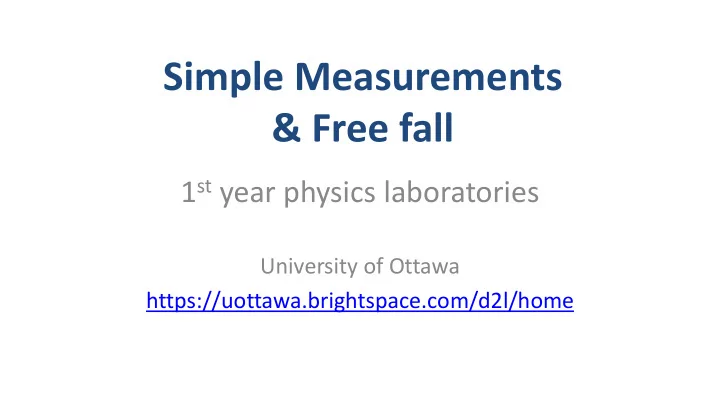

Simple Measurements & Free fall 1 st year physics laboratories University of Ottawa https://uottawa.brightspace.com/d2l/home
SIMPLE MEASUREMENTS The TA will go over the following tutorials. • Error calculations – There is a test on error calculations on the lab website. – You may complete the test as many times as you want until the deadline. Only your highest mark will be recorded. • How to use the following instruments: – Meter stick – Vernier caliper • Rounding and significant figures.
ERROR CALCULATIONS Propagation of errors: addition and subtraction If the result 𝑆 is obtained from a series of additions and subtractions: 𝑆 = ± 𝐵𝑦 ± 𝐶𝑧 ± ⋯ , where 𝐵 and 𝐶 are constants, then the error on the result 𝑆 is given by 𝐵 2 ∆𝑦 2 + 𝐶 2 ∆𝑧 2 + ⋯ ∆𝑆 = See tutorial – Propagation of errors pg. 1
ERROR CALCULATIONS Propagation of errors: multiplication and division If the result 𝑆 is obtained from a series of products: 𝑆 = 𝑦 𝐵 𝑧 𝐶 ⋯ , where 𝐵 and 𝐶 are constants, then the error on the result 𝑆 is given by ∆𝑆 = 𝑆 𝐵 2 ∆𝑦 2 𝑦 2 + 𝐶 2 ∆𝑧 2 𝑧 2 + ⋯ See tutorial – Propagation of errors pg. 2
REPEATED MEASUREMENTS When dealing with multiple measurements, we use the statistical quantities: mean (or average), standard deviation , and standard error ( SE ) to interpret our data. - The mean (or average) is an estimate of the “true” value of the measurement. - The standard deviation is a measurement of the “spread” in your data. If you took one more measurement, you can be ~70% sure that this value will be one standard deviation away from your mean. - The standard error is an estimate of the uncertainty in the mean value. If you repeated your experiment, you can be ~70% sure that the new mean will be one standard error away from your original mean. See tutorial – Repeated Measurements
MEASURING INSTRUMENTS See tutorial - Measuring techniques Vernier caliper: for lengths between 1 cm and 10 cm
MEASURING INSTRUMENTS Absolute uncertainties: • Meter stick: ± 0.5 mm (per reading) • Vernier caliper: ± 0.05 mm • Balance: ± 0.1 g • Stopwatch: ± 0.2 – 0.5 sec
SIGNIFICANT FIGURES AND ROUNDING See tutorial – Experimental errors pg. 6
LAB 1: OBJECTIVES • Part 1: Length measurement – Measure dimensions of objects to calculate their volume and density – Determine material type from a density table – Use uncertainty and perform error calculations • Part 2: Time measurement – Measure the period of oscillation of a mass-spring system – Determine statistical quantities such as average, standard deviation, and standard error • Part 3: Picket fence free-fall – Use automated data acquisition to determine velocity of a free-falling object. – Generate a graph of velocity vs. time for the object and use a linear regression tool to determine the gravitational acceleration constant, g .
Part 1 - Length measurement The objects and instruments: Meter stick Micrometer Meter stick Micrometer Vernier caliper Vernier caliper
Part 2 - Time measurement The mass-spring system: Record the period of oscillation for the 200 g mass on the spring. Spring Mass (200 g) Stopwatch
Part 3 - Picket fence free fall The setup: Photogate Record velocity and time data for the picket fence falling through the photogate. Foam mat Picket fence
CLEAN UP • Turn off the computer. Don’t forget to pick up your USB key if you used one! • Put back the objects and measuring instruments all together neatly on your table. • Recycle scrap paper and throw away any garbage. Leave your station as clean as you can. • Push back the monitor, keyboard and mouse. Also please push your chairs back under the table.
DUE DATE REMINDER: TESTS! Do the 4 tests in Exp. 0 folder before The report is due in one week before 5 pm. the due date! Please drop off your report in the LAB PRE-LAB dropoff box located in the central corridor of STEM 3 rd floor, south tower. Don’t forget to do your pre -lab for Exp. 2! Don’t wait until the last minute, there will be no extension for students experiencing technical problems a few minutes before the deadline!! NEXT LAB Your next lab is not a take-home! It will be due at the end of the lab session!
Recommend
More recommend